#pretty sure some of his old kilts can be found in museums
Note
How many kilts total are in Scotland's closet?
Surprisingly, he only has a handful of them at a time but he takes great care of them. It's almost ceremonial in the way he takes time to keep them in perfect condition. Even though the kilt only first appeared by the 16th century, it became an important part of Scotland's identity, especially after the Dress Act 1746.
He had kilts from different clans over the years but he always keeps one from Clan Donnachaidh, also known as Clan Duncan and one of the oldest clans in Scotland. It holds a special importance for him because it was the first clan he was part of.
However, although he takes great pride in showing off his kilt and looks regal in wearing it (even if wore casually), he won't hesitate to combine it with the gaudiest and tackiest of shirts.
#hetalia#aph scotland#hws scotland#pretty sure some of his old kilts can be found in museums#and he's smug about it when he reads the little description card saying it's in pristine condition even though it's centuries old#also for the anon who asked about the tie dye shirt kilt#I didn't forget you!! I just want to draw it but haven't got the time lol
12 notes
·
View notes
Text
Day 125: Hadrian’s Wall and the Scottish Borders
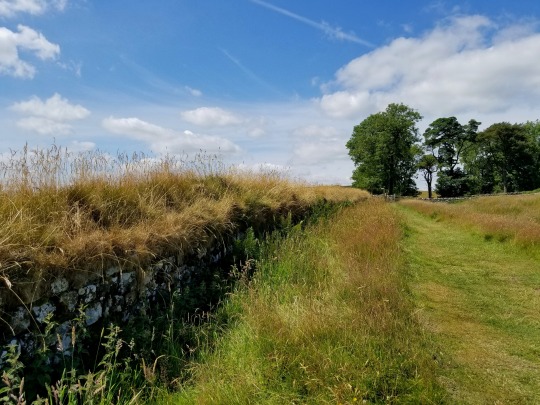
When we first started planning this trip, one of the big sites I'd wanted to see was Hadrian's wall. But it's so far from anywhere else we wanted to go in England that I had resigned myself to the fact that I probably wouldn't get to go. Luckily, Rabbie's offers a tour of the wall from Edinburgh. Not only would we get to see Hadrian's Wall, we'd get to approach it from the north like an old Celtic barbarian.
It was a long tour, so we had to get up and into town early.
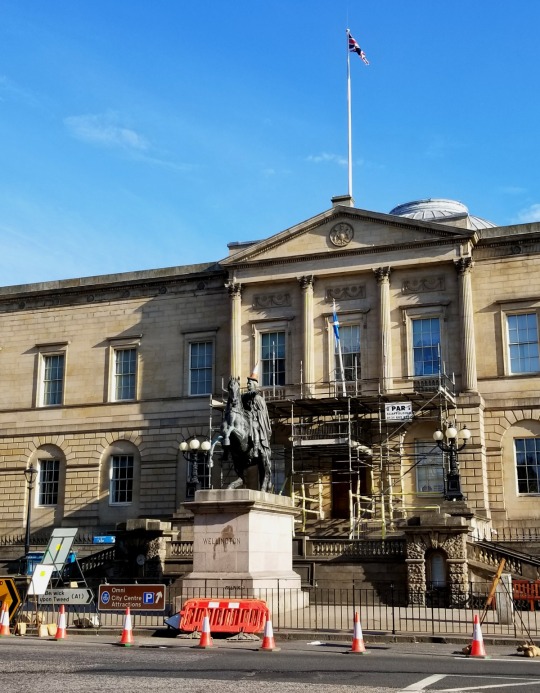
There must have been quite the party going the night before. Even the statues woke up with traffic cones on their heads.
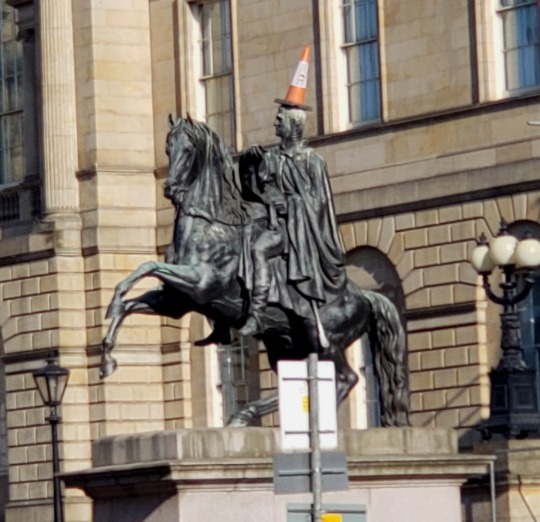
Our guide and driver for the day was Nik, a middle-aged, born-and-bred Edinburgh man with the accent and stories to prove it.
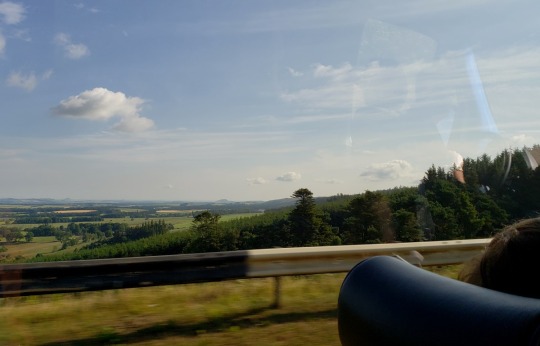
As we drove south, we passed through the beautiful rolling hill country that makes up the Scottish Borders. The Highlands are seem to get all the glory when it comes to romanticizing Scottish countryside, but the Lowlands definitely have their own idyllic charm.
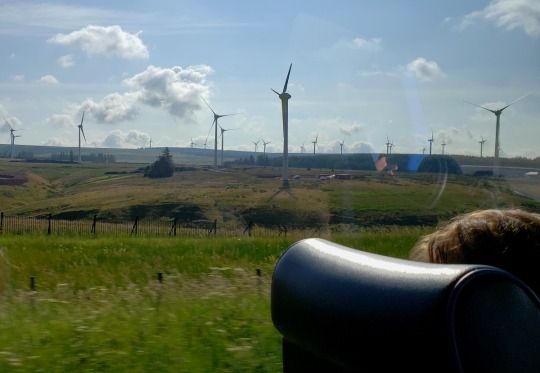
Nik told us some interesting stories about the medieval residents of the Borders and their complex relationship between England and Scotland. They were ethnically Scottish, but the Borderers resented both countries because their wars inevitably brought the razing and pillaging of border towns by both sides.
The Borderers were excellent horse riders and highly valued as mercenary cavalrymen throughout Europe. Whenever the English and Scottish armies fought in the Borders, the Borderers would hire themselves out to both sides, then sit on the sidelines of each battle until the winner was clear. They made special coats with English colors on one side and Scottish colors on the other, so they could flip their coats inside-out to match whichever side they decided to be "fighting for" at the moment. Hence the term "turncoats."
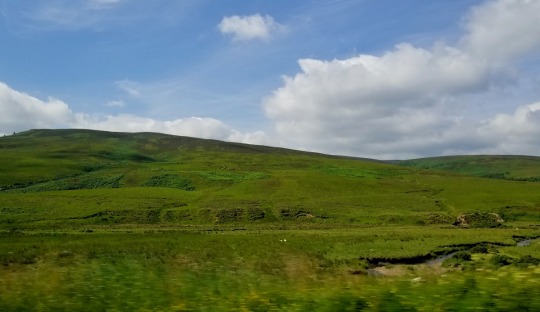
When they weren’t fighting as mercenaries, the Borderers spent a lot of time fighting themselves. One town would gather a raiding party and invade the next town over. That town would then gather a counter-raid to get their stuff back. Eventually, the raids became so bad that towns hundreds of miles away–well outside the Borders--were being raided by these crazy hill people. Neither country wanted to take responsibility for them, but when King James VI and I united Scotland and England under one crown, he was able to raise a police force to move in and establish order.
We also saw a lot of sheep on our drive. According to Nik, there are three sheep in Scotland for every man, woman, and child. Which is the perfect number, he said–one for meat, one for wool, and one for snuggling.
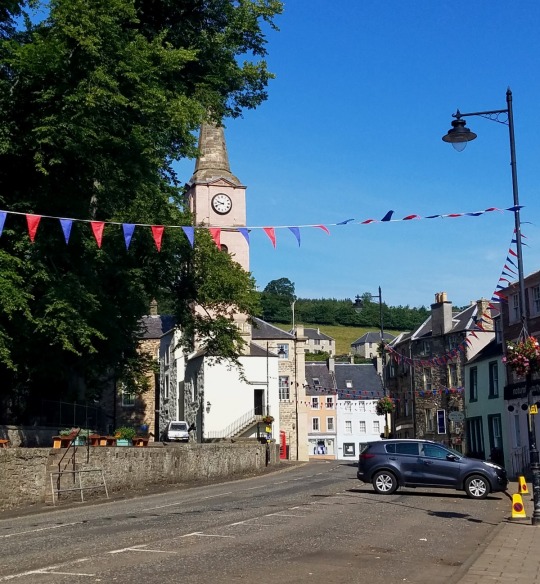
Our first stop was the abbey town of Jedburgh, just ten miles north of the border with England. Streamers hung up all over the town indicated that a festival was going on, but it was dead quite on this Thursday morning.
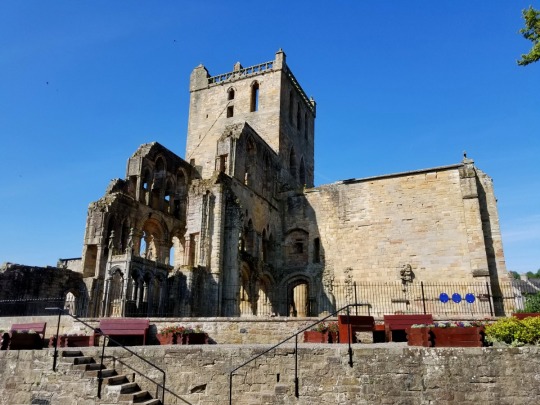
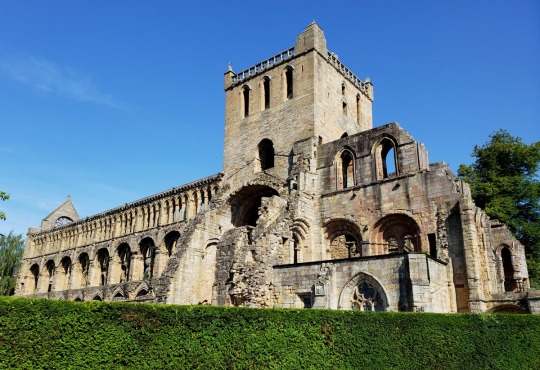
The abbey, like most abbeys in Britain, is only a picturesque ruin now. But this time it wasn't Henry VIII's fault--the Scottish destroyed their own abbeys during their own Presbyterian Reformation.
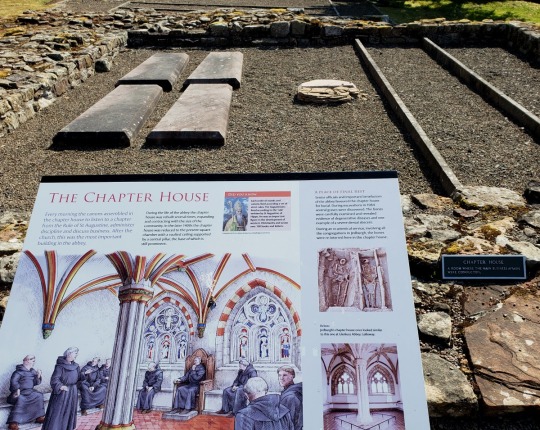
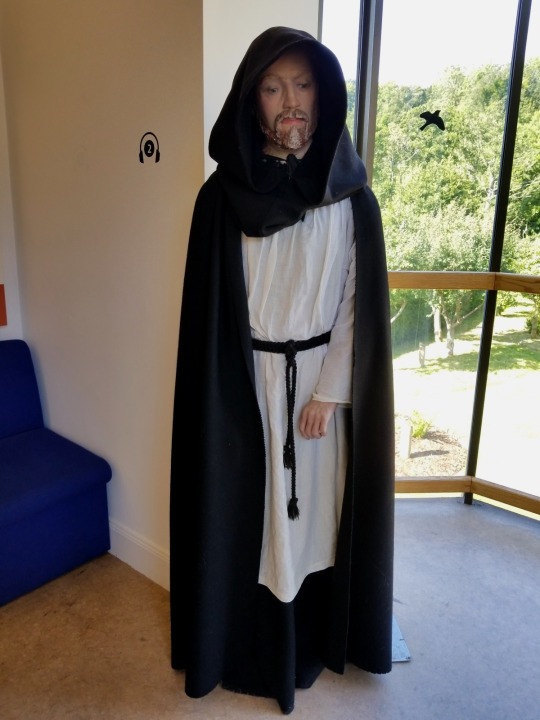
Before its destruction, the abbey was inhabited by Augustinians, who were known as cannons rather than monks. Whereas monks live and work in their abbey, cannons are priests who choose to live communally in an abbey but still teach and perform services in their local community.
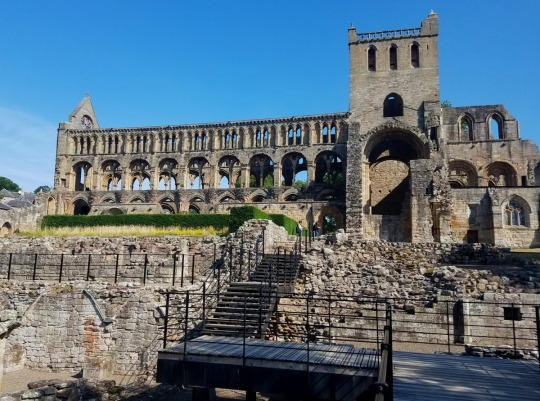
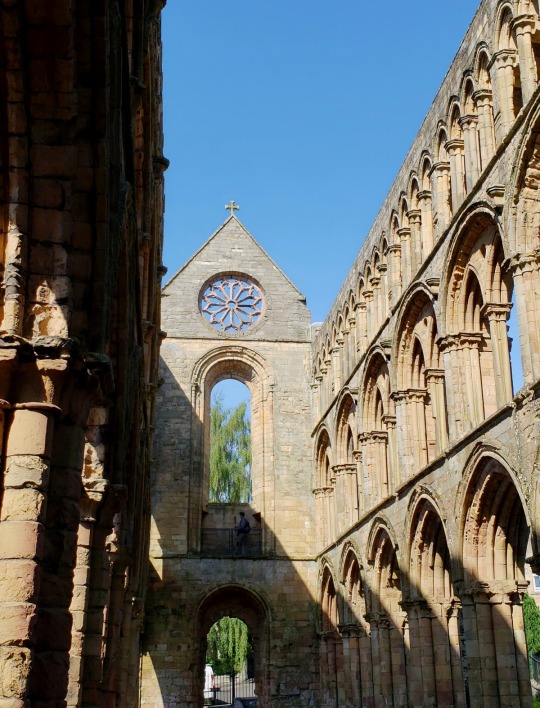

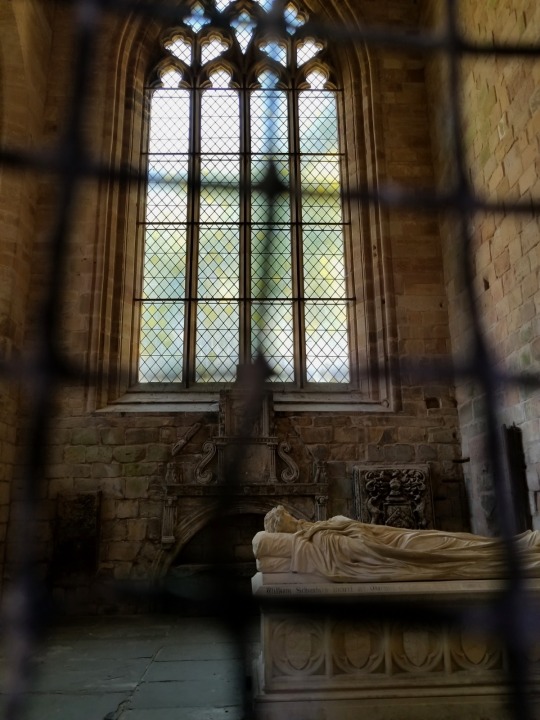
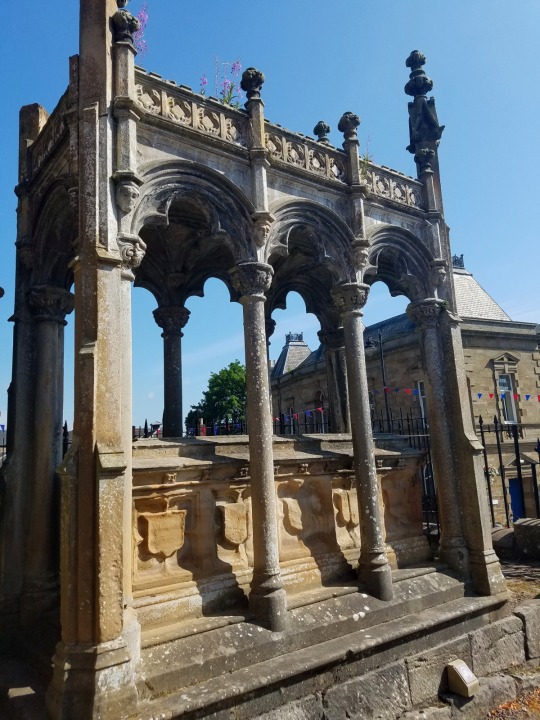
We got about an hour to explore the small museum and wander through the peaceful ruins.

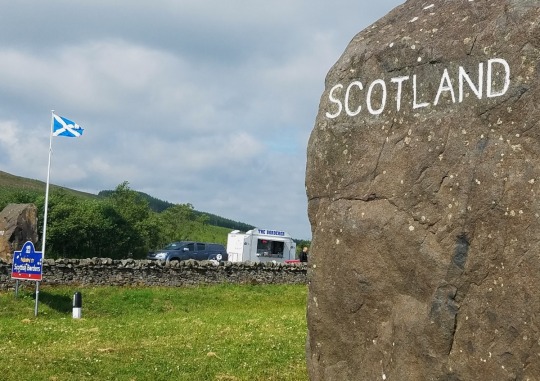
Next we headed down to the crossing between England and Scotland, where we pulled over for a quick photo op. There's no security or anything, just a pair of engraved standing stones.
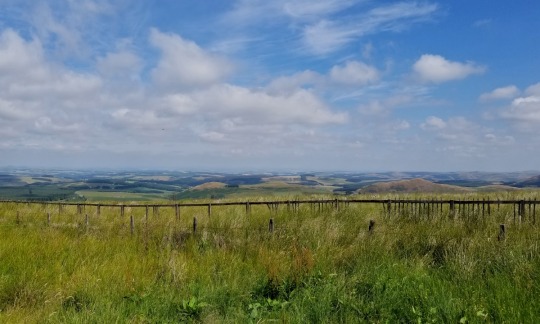
The view was fantastic, though.
Our timing was good, too. Just as our group finished taking pictures, a kilt-clad busker showed up to serenade us with his bagpipes. More oddly, a man driving through the parking lot stopped and called one of our group mates over so that he could give her some sort of "helpful" pamplet. According to Nik, this guy is a regular feature at the crossing who stages this sort of thing all the time, making it seem like he's just a friendly local who randomly decided to pull over and give the handout to a passing tourist.
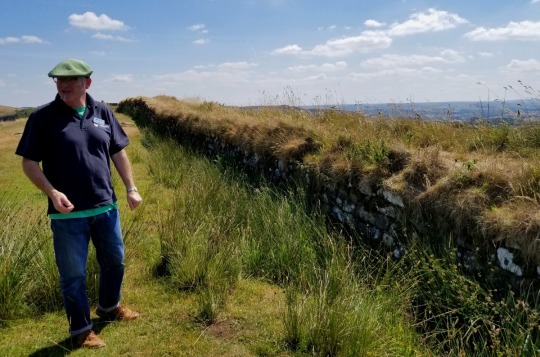

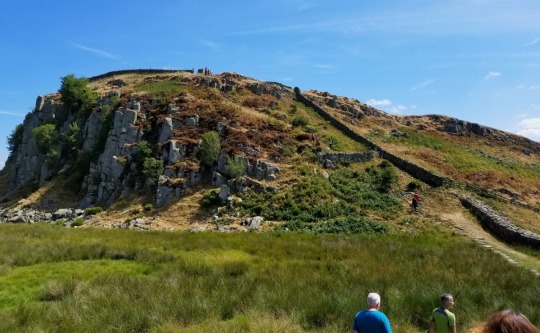
After a few very pleasant hours of driving (some of which my dad and I might have spent dozing), we arrived at Hadrian’s wall. Specifically, we arrived at Steel Rigg, a dramatic line of glacial crags that the wall runs along the top of.
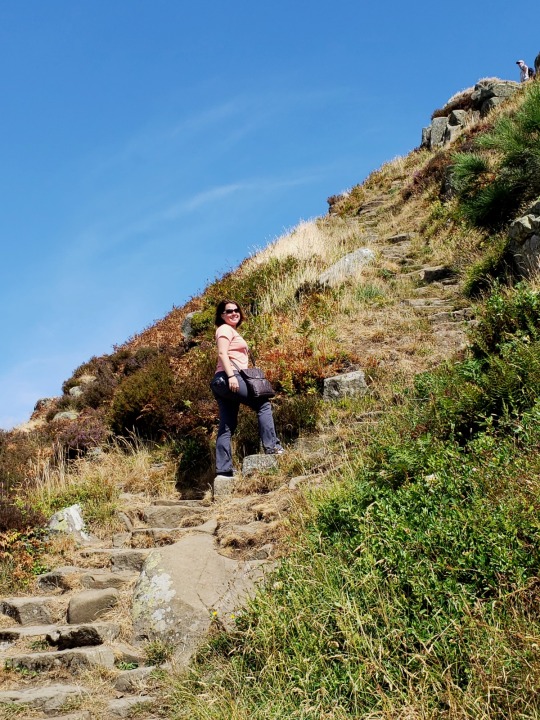

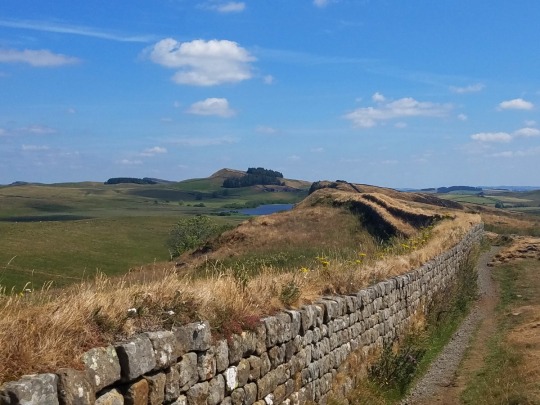
It was a steep climb up to the top of the outcrop, but the view was well worth it. Even if the wall was never really used as a defensive installation, it was easy to imagine hordes of painted Celtic barbarians massing to the north.
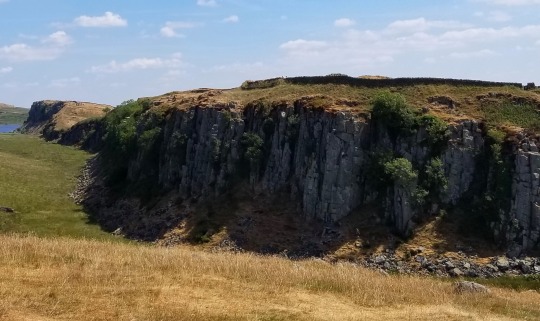
And seeing the way crags rise up like a wall themselves, I can very easily understand how George R.R. Martin was inspired by this place to create his fictional wall of ice in A Game of Thrones.
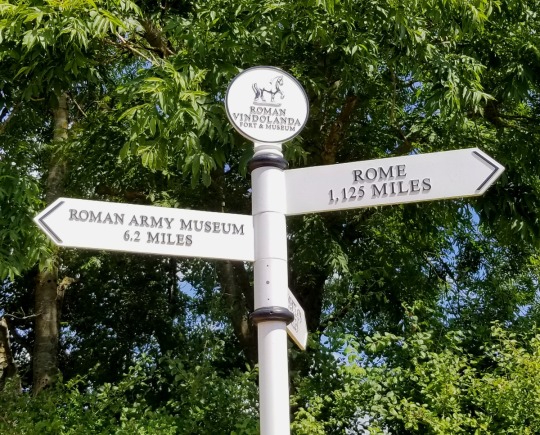
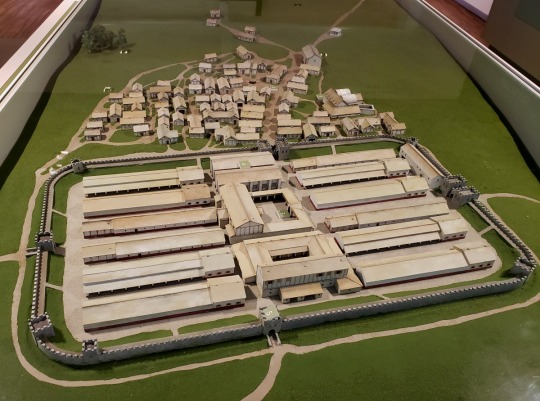
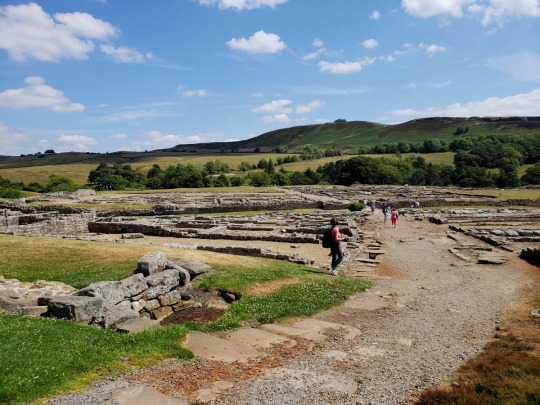
Next, we went to the nearby Vindolanda excavation and museum. Vindolanda was a Roman walled settlement inhabited by the soldiers who manned Hadrian's wall, as well as their families and the various merchants and artisans who supplied them. The site has been meticulously unearthed, and the included museum is filled with fascinating artifacts from the Roman inhabitants’ everyday lives.

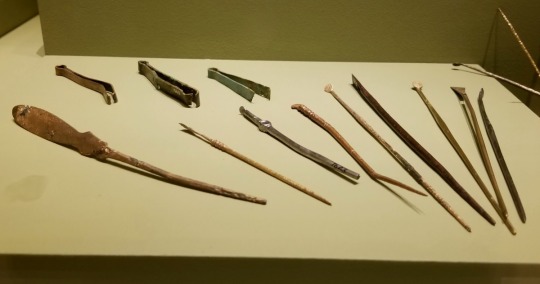


There was pottery, flatware, tweezers, and lots and lots of leather shoes. The Romans wore very intricate leather shoes, but apparently very few examples are still around. Vindolanda is a treasure trove of leather and wooden goods because the land it's on is basically a bog--pretty much the same story as with the Celtic artifacts we saw at the Irish National Museum of Archeology in Dublin.

Despite being such innocuous pieces, one of the collections that struck me the most was the wooden barrel staves on display. We could see the ancient branded markings in old Latin clear as day, and one stave still bore a round stain from when some Roman set something dirty on it. The world's oldest coffee ring, perhaps?
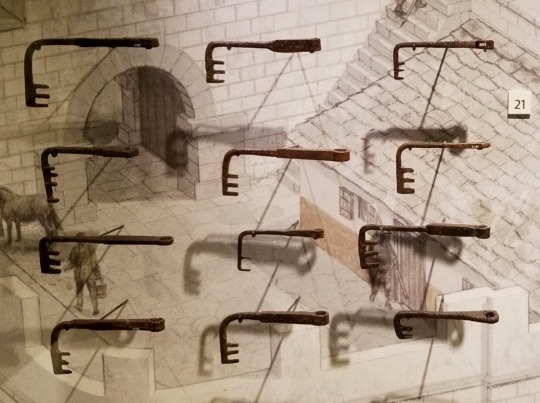
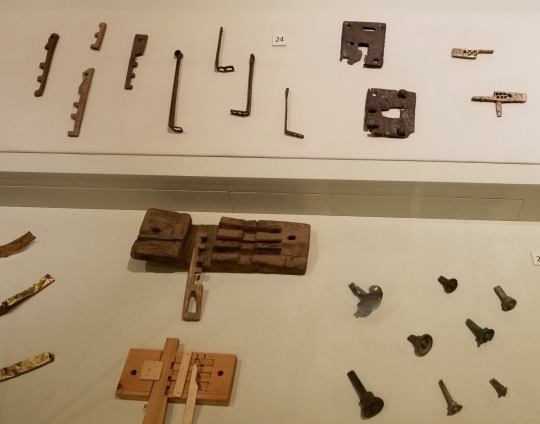
There was a fascinating collection of Roman locks and keys that were much more intricate than what I would have assumed they had at the time.
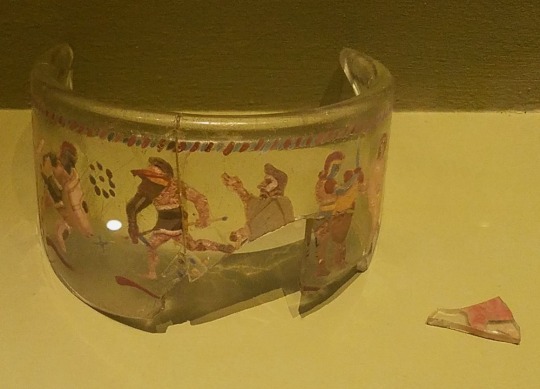
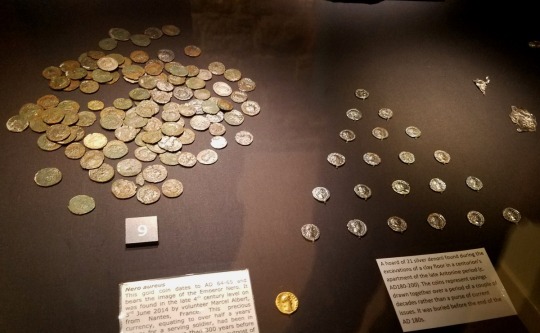
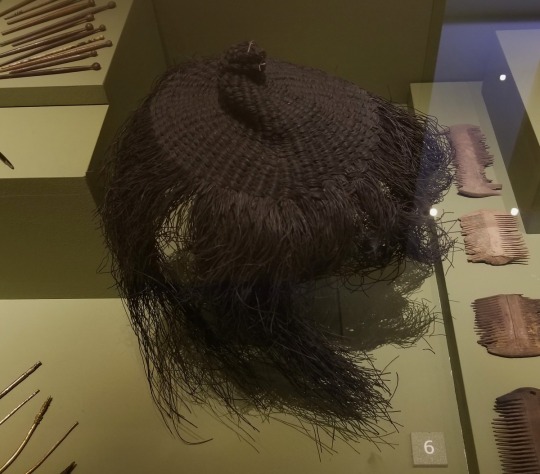
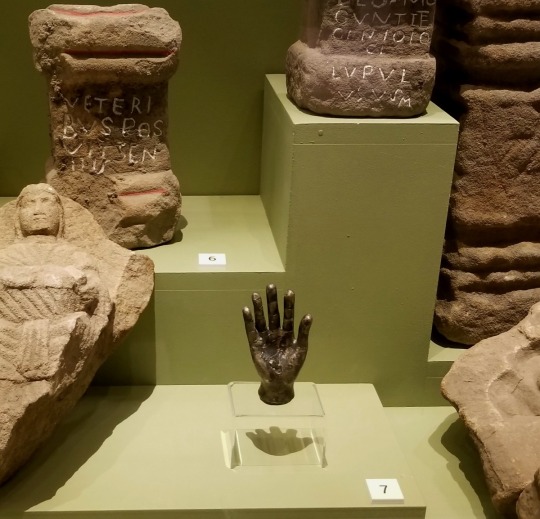
Other interesting finds in the museum included a piece of intricately painted glass that had been imported from Roman Germany, some surprisingly shiny Roman coins a bug-resistant wig made from local moss, and a small metal hand used for religious ceremonies.
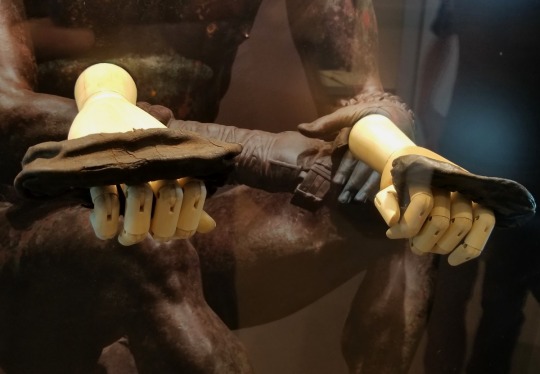
But the pride of the museum's collections was a barely distinguishable pair of leather boxing gloves. Boxing was a favorite pastime in the Roman Empire, and there are countless artistic depictions of soldiers and gladiators wearing an ancient form of boxing gloves. But these gloves found at Vindolanda are the only known surviving pair in the entire world.
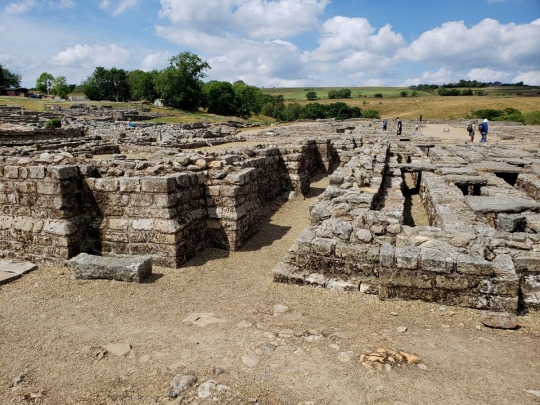

Normally, there is an afternoon guided tour of the ruins, but today's tour was replaced with a performance by a group of local Roman Legion reenactors.
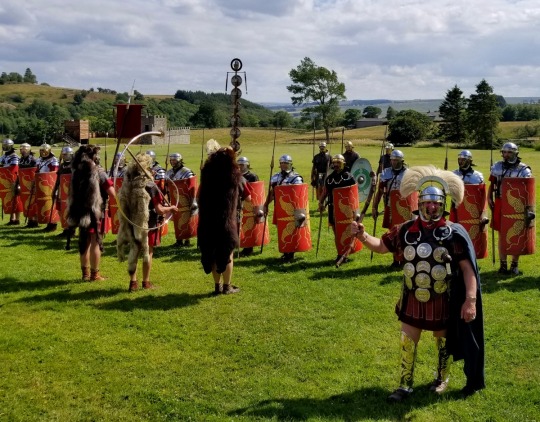

They described their arms, armor, and troop composition. We learned that up until the mid-20th century, historians didn’t actually know for sure how the iconic Roman segmented plate armor worked. It wasn’t until an old wooden chest under someone's house was discovered to contain two intact sets that people were able to accurately recreate them. And by recreating them, historians and reenactors can learn firsthand how they work and would likely have been used.

And you know you're in for a treat when your tour guide is excitedly taking pictures along with the rest of the group.

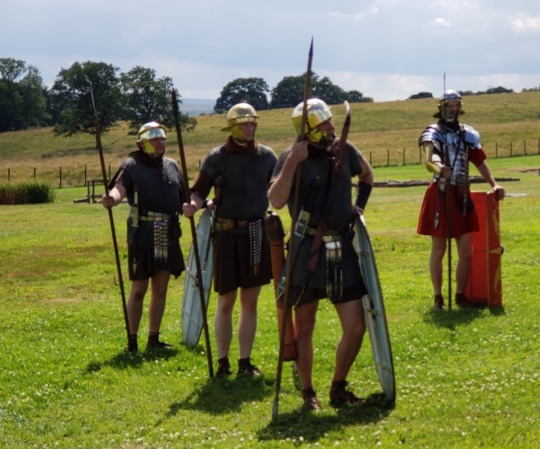
We learned how most of the soldiers manning Hadrian’s wall would not have actually been Legionnaires, but rather auxiliaries. Auxiliaries were non-citizen soldiers who fought for the Roman army in exchange for citizenship after 25 years of honorable service. In the meantime, they got less money, worse equipment, and more dangerous postings.

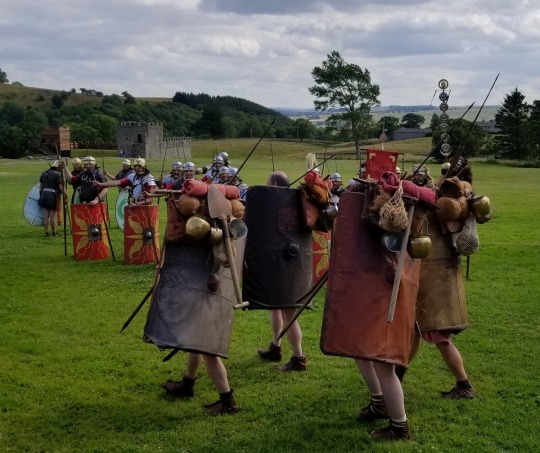
The reenactors also described how the invincibility of the Roman army was not just due to the superiority of their arms and armor. At the time, the Romans basically reinvented the idea of a professional, standing army. The Celts of Scotland had a proud and fierce warrior culture, but they didn’t really have armies. When one clan went to war against another, they would just gather all the able-bodied men together and head out. They were strong and fierce, but they just didn’t have the skills and tactics that full-time soldiers are able to develop through years of constant, structured practice.

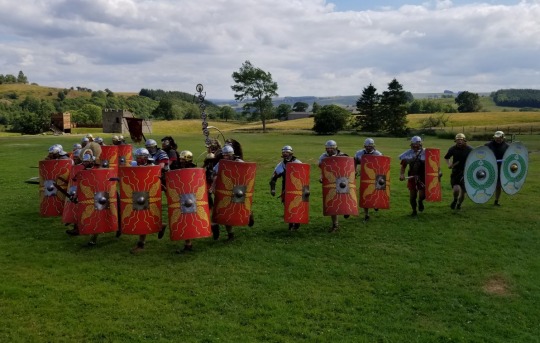
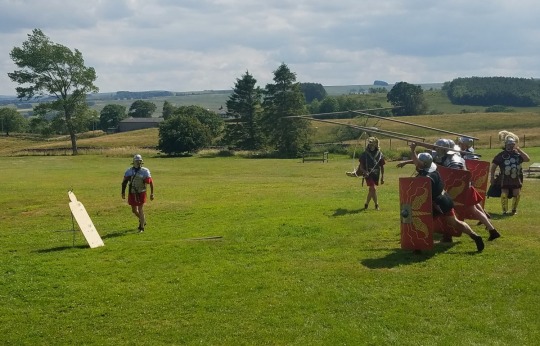
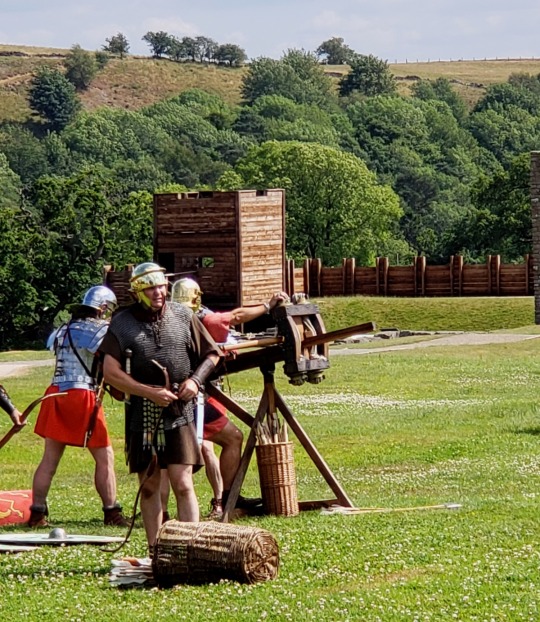
We got to see the reenactors charge, duel, throw spears, and even fire a ballista (basically a giant crossbow, for anyone who's never played Age of Empires).
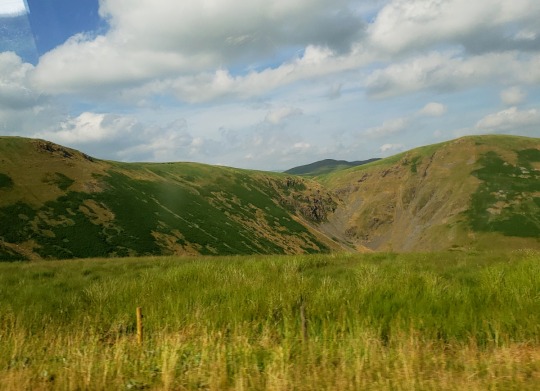
Leaving Vindolanda, we headed back up to Edinburgh through the western Lowlands. Again, the rolling hillsides were spectacular. I was especially enthralled by the area around the River Tweed, the home of a famous British textile. We could easily see how the raiding parties Nik described could hide out in a fog-cloaked ravine and become virtually unfindable. Nik also pointed out the particular hillsides where the wild haggis love to run free--in circles, of course, because of their naturally lopsided legs.
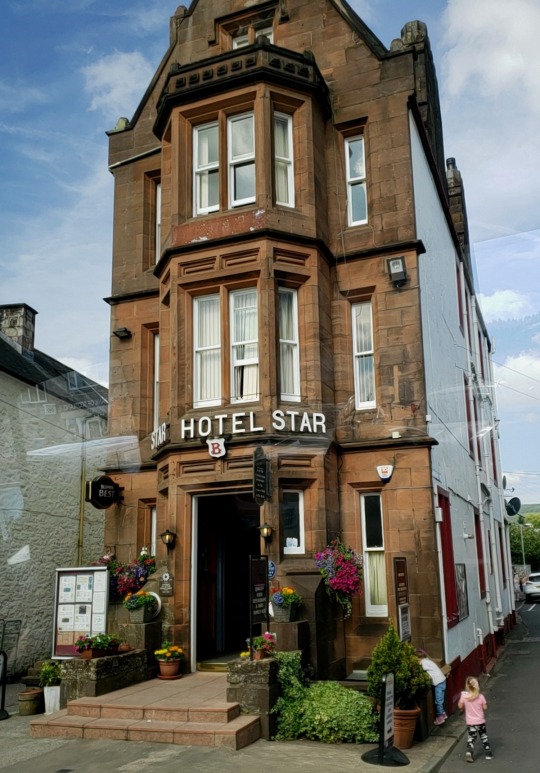
We also passed by the narrowest hotel in Britain.
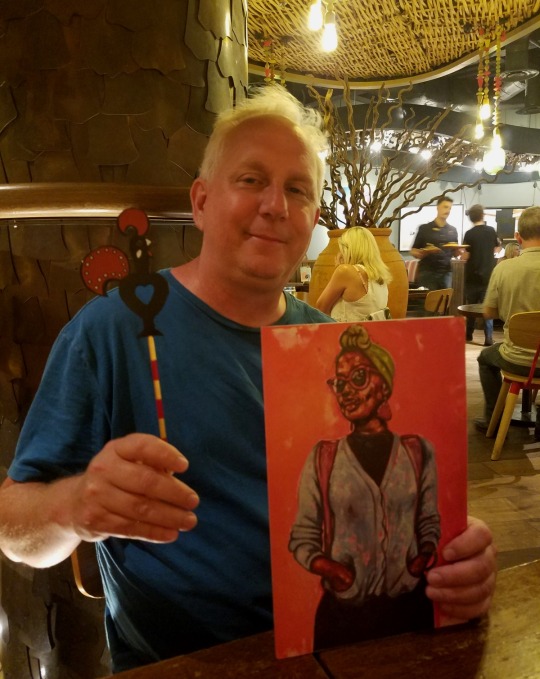
Back in Edinburgh, we finally got my dad his first taste of Nando's before heading back home. It was in a shopping mall at the edge of Old Town, and it was about an hour's wait between when we first put our names down on the waiting list and when we actually got our food. It was well worth it, though--especially considering that it would be our last Nando's of the trip.

Back home, we rested up and prepared ourselves for our last two days in Edinburgh. We would be staying in the city, and we had almost all of it left to see.
Next Post: Edinburgh, Part 2 (History, Hiking, and Beer)
Last Post: Glasgow
#180abroad#edinburgh#scotland#lowlands#scottish borders#hadrian's wall#vindolanda#ancient#rome#roman ruins#history#travel
3 notes
·
View notes
Text
A new Beginning Chapter 4
After MANY MANY MANY Rewrites here is chapter 4. I’m so sorry for the wait.
The Reverend was watching Brianna while Claire was working at the hospital. He loved having her around. It made him feel young again...in heart and mind at least. He had the bairn with him sitting in a highchair that he put in his office so that Brianna could be entertained while he did some searching. It was nearly the holiday season and he wanted to make it special for Claire. He wanted to find things that she had when she lived in Scotland with Jamie.
He found out that Jamie took a job as a printer under the pseudonym A. Malcolm. By the looks of Jamie’s papers he printed papers that went against the crown.
“Dangerous and gutsy,” he thought. “Considering the Redcoats went from town to town, destroying anything and everything that had to do with going against the crown.”
Knowing what he did about life after Culloden off the top of his head living in Scotland after the battle was difficult and food was scarce. If Jamie went to Edinburgh to find work of any kind it was because things at home were desolate.
On closer inspection of the papers he noticed a poem by Robert Burns entitled
“My Highland Lassie O’”
Nae gentle dames, tho' e'er sae fair,
Shall ever be my muse's care:
Their titles a' arc empty show;
Gie me my Highland lassie, O.
.-Within the glen sae bushy, O,
Aboon the plain sae rashy, O,
I set me down wi' right guid will,
To sing my Highland lassie, O.
O were yon hills and vallies mine,
Yon palace and yon gardens fine!
The world then the love should know
I bear my Highland Lassie, O.
But fickle fortune frowns on me,
And I maun cross the raging sea!
But while my crimson currents flow,
I'll love my Highland lassie, O.
Altho' thro' foreign climes I range,
I know her heart will never change,
For her bosom burns with honour's glow,
My faithful Highland lassie, O.
For her I'll dare the billow's roar,
For her I'll trace a distant shore,
That Indian wealth may lustre throw
Around my Highland lassie, O.
She has my heart, she has my hand,
By secret troth and honour's band!
Till the mortal stroke shall lay me low,
I'm thine, my Highland lassie, O.
Farewell the glen sae bushy, O!
Farewell the plain sae rashy, O!
To other lands I now must go,
To sing my Highland lassie, O.
A .Malcolm April 3rd 1752
“Well if this isn’t a call to you Lass. I don’t know what is,” The Reverend thought.
He knew and he was sure Claire knew that Robert Burns wasn’t going to be born for another seven years. The only plausible explanation of a Robert Burns poem being published before it’s time was Claire told him about Robert Burns and the poem. And this is his way of letting her know that he is alive.
The Reverend put the paper aside and went on looking for anything he could find. He found the tale of The Don Bonnet and how he survived in a cave on the outskirts of the Lallybroch land. He wondered if he would be able to find the cave and if he did what would he find? A coded message to Claire and the bairn or nothing at all? It was all so intriguing to him. The man had suffered so much and yet survived, he survived hoping but not knowing if his wife and child had made it alive.
“That must have been gut wrenching agony for him,” He thought.
Hours past when he was began researching the Museum for the Battle of Culloden. He wondered if he would find anything of Jamie’s there, Next he called the library where old deeds to land in the eighteenth century were located in Inverness. A nice lady named Gwen took the call and was very helpful in find the deed to Lallybroch.
“I’d like to help a family friend with her family heritage for Christmas,” he answered when asked why he was interested.
“Can I buy it?” He asked.
“Yes, but it’ll cost a pretty pound.”
“That doesn’t matter, please put it on hold for me.”
“I can hold it for you for forty-eight hours.”
“Thank you, I’ll see you tomorrow morning,”
The Reverend couldn’t believe his luck he had found the deed to Lallybroch.
The Reverend went to the kitchen to tell Mrs. Graham the news and she whole-heartily agreed to watch Brianna while he went to the library and the museum.
The more Mrs. Graham thought about it, the more she wanted to go to the museum and didn’t see a problem taking Brianna with her, so she posed the solution to the Reverend.
“That way you have more time at the library.”
“That’s a wonderful idea, thank you for your help Mrs. Graham.”
“You’re welcome, but really, you should have asked sooner, I’d love to help with this project.”
“Now sit down and tell me what else ye found.”
He did. He told her of the Robert Burns poem he found written in a paper in 1752 under the Pseudonym A. Malcolm. He told her of finding the cave of Don Bonnet and the story of the man, he spoke of finding what he hoped was the piece of amber that Claire had given Jamie before she went through and maybe one of his kilts. And then the deed to Lallybroch.
He finished just as the roast and potatoes finished. Getting up to pull them out of the oven she turned back and said.
“That’s quite an undertaking man, what if we can’t deliver?”
“We can at least deliver the deed, everything else is icing on the cake.”
At that moment they heard a car pull up and the door slam shut.
As they were finishing getting dinner on the table Claire came through the front door looking a little worse for wear.
Coming through the front door and following the aroma to the kitchen where she found the three of them sitting at the table she smiled and said
“Smells delicious.”
“Thank you dear, how was your day.”
“It was tougher than usual.”
“Would you like to talk about it?” the Reverend asked.
“Not at the moment, thank you,” she replied.
Dinner was eaten in companionable silence with Claire thinking about whatever had happened that day and Mrs. Graham and the Reverend planning their outings for the next day.
#myfanfiction#my fanfiction#myfanfic#Outlander#briannafraser#clairefraser#jamie x claire#Jamie Fraser#jamiefraser
27 notes
·
View notes
Text
Best and Worst of the Isle of Skye #244
The 2018 Celtic Invasion of the Isle of Skye is over. We had an amazing vacation.
Every year, I ask my invaders for feedback. This year, I decided to do it a little different. I wanted to help you figure out what were some of the best things to see when you come visit.
So I’m gonna share my Best and Worst things to see on the Isle of Skye, followed by feedback from Invaders, including some of their favorites.
Best of the Isle of Skye.
My favorite thing in Skye was the Quiraing. This is up in Trotternish. It’s June, lush and green with powerful, towering mountains.
Now Skye is a big hiking area. I think most people go to Skye to hike.
Most of our Invaders were not big hikers. We were all happy to hike and explore. But the hardcore hiking was not for us.
Now I’m sure there’s some difficult hiking in the Quiraing, but the two places we visited were fairly easy. A third place looked even easier.
I guess for me there was more room to relax and enjoy the magnificent mountain range in the Quiraing. If you’re looking for one thing to do in Skye, this is my suggestion.
My second favorite thing to do in Skye was the Skye Cruises out of Uig. They offered a three-hour boat tour of the ocean and shoreline. We saw a castle, seals, and even watched puffins flying about.
The captain was very friendly. He and a friend started this cruise a couple years ago. It made for a very pleasant experience.
They provided free snacks and drinks including Skye Beer from the local brewery. They had binoculars available for seeing the sea life too.
Of course, it probably helped that the seas were calm. There was a little bit of rain that fell on us for about ten minutes. Then it was done.
They had some good Celtic music playing in the back of the boat. And up front, I played songs and along with Pace. And happily Danny and Christine Faught of Green Man Clan joined us.
Okay so that was a benefit of me boating out there. Nevertheless, it was a wonderful relaxing trip.
Third in my list of the Best of the Isle of Skye we’re The Fairy Pools.
On day three of our Invasion, we got a tour guide to take us to The Fairy Pools. The guide was kind of a flop. Not much more than a driver sadly. But the Pools were brilliant. Tho a little tricky too.
It was raining when we arrived. We walked down the hill to the starting point.
I say walk, but to be honest l, there was a little sliding. I had my bad shoes. The ground was moist and squishy. So I fell a couple times. That didn’t bode well.
At the bottom of the hill, there was a stream and no way to cross it but get your feet a little wet.
I wasn’t quite in the mood to plunge in. In fact, I was about to skip it. I’m glad I didn’t. I took off my shoes and walked across the small stream.
After that, the walk was a breeze. It was a gentle slope into the valley. A river guides you on the right. And all along it are bunches of small waterfalls and “Fairy Pools”.
I didn’t go all the way into the mountains. I took my time and had fun making videos. I sat with my feet in the freezing water. It was delightful. Again, I’m so happy I went.
The fourth coolest thing for me was the excitement of finding dinosaur tracks.
So we stayed in Staffin Bay Cottages. They are located a 3 minute drive from Staffin Bay Slipway. When we arrived, we learned that there were dinosaur tracks down there.
So one evening, we hiked over to the beach and looked for the tracks. It took some time to find them, but eventually we did. They were covered in seaweed.
They were also difficult to make out. But we went to the local dinosaur museum to confirm.
That was cool and all. But 2-3 months ago, new tracks were discovered at Brother’s Point. On Friday, we finally headed to the point. We arrived just before low tide.
So I should point out that there are no markers for these prints. You have to find them.
Now what I learned at the dinosaur museum was the footprints were found in sedimentary rock.
The first step was to find that. I am no geologist. But I did overhear, that sedimentary rock is layered rock. Most of the rocks out there, I think, are igneous.
I found a big slab of sedimentary rock and started looking. I found some small impressions and called over Pace and Selena. Pace told me that they were about a foot in diameter.
I spent the next thirty minutes staring at the rock. How weird is that!
Eventually I noticed differences. I saw breaks in the rock and looking at puddles, I realized the indentations were different from the breaks. I called over Pace and we jokingly decided we found dinosaur tracks.
I got some pictures and videos but I don’t think you’ll see much of anything.
Pace got a good picture. We decided to take his picture to the dinosaur museum to confirm it. We were thrilled they said yes!
Yay. I’m officially an amateur dinosaur track hunter.
I was trying to settle on my top 5 of Skye but I couldn’t. So for number five, I picked two.
First is the Skye Museum of Island Life. It’s located in the north end of Trotternish. It was a small Croft community. But now it’s a museum.
I guess I liked it because it’s the only bit of history we got on Skye. That’s because this was also the place that Flora McDonald was buried.
Flora is the woman from the song “Skye Boat Song” who carried the Bonnie Prince Charlie to safety after his defeat at Culloden, which marked the end of the Jacobite Revolution.
The museum told that story along with the story of the crofters.
I also loved Neist Point. There’s a lighthouse and soaring cliffs and gorgeous ocean vistas. It was stunning.
I also recorded a couple videos while I was out there.
That was my best of the Isle of Skye.
What was the worst?
I’m sure many would disagree, but my least favorite thing about Skye was Old Man of Storr.
There are some stunning pictures of Storr. As far as I can see, they are either aerial photographs or from way up top on Storr. I don’t have an airplane, and I didn’t have the desire to climb all the way to. I climbed up thru the third gate. About halfway. The view was nice. But not worth the effort. I’d rather go back to the Quiraing.
Kilt Rock a beautifully named with almost pleated rocks. But it’s view is located in a very safe and boring park off the road. It was uninspiring.
I was disappointed with Talisker Distillery. I like the whisky, but there was no tasting room. You had to do the tour.
I’ve done whisky tours before. They’re mildly interesting. It’s the whisky that’s the best thing about them. I bought a bottle but even the store was limited. I think I’m a bit spoiled by Guinness and Bushmills. They’ve got a TON of incredible shops. Plus tastings.
Now it’s not a least favorite location but Skye is pretty windy. When it isn’t windy, at least during the summer, the midges are our in full force. Midges are small biting gnats. Think of tiny barely visible mosquitoes. Unless they’re swarming.
During the summer, restaurants book up. So make sure you get reservations unless you’re fine with eating at 9 or 10 o’clock.
Finally, this is the ultimate in #FirstWorldProblems. But the internet was worse here than pretty everywhere we’ve invaded. Bad internet and bad cell phone.
I know. I know. Whine whine whine. You’re on the Isle of Skye!
But I was wanting to stay in touch with my girls back home and was sorely disappointed. The house internet was slow. The data on my phone didn’t work at all. Our house was a dead zone for phones as well.
I guess the point is you should expect to disconnected.
Alright. That’s what I thought of Skye. Let’s see what folks thought of the Celtic Invasion of the Isle of Skye.
--
I hope you enjoyed my Invader feedback. Again, the Celtic Invasion of Skye was a huge success. I'm excited to share some photos and videos from the trip in the coming months.
Now I just announced the net two locations that I am planning for the future. In 2019, we're gonna have the Celtic Invasion of Star Wars... We're going back to Dingle, Ireland and this time we're gonna visit Skellig Michael. That's the island from The Last Jedi film.
Then in 2020, we're going to Venice, Italy. This is the Origin of Celtic Invasions Vacation. Because the area was conquered by a Celtic tribe called the Veneti that later migrated to Brittany in France, before heading to Cornwall, Wales, Scotland and Ireland.
If you find out more about that history, check out two episodes I released last year: The Secret History of the Celts #231 and History of Celtic Brittany #232.
And head over to CelticInvasion.com if you want to join one of these awesome vacations.
Now I want to ask you to head on over to Spotify and Follow My Music.
You will find links to everything I mentioned in the shownotes at Celtfather.com where you can also subscribe to this podcast and download 21 songs for free.
Check out this episode!
0 notes